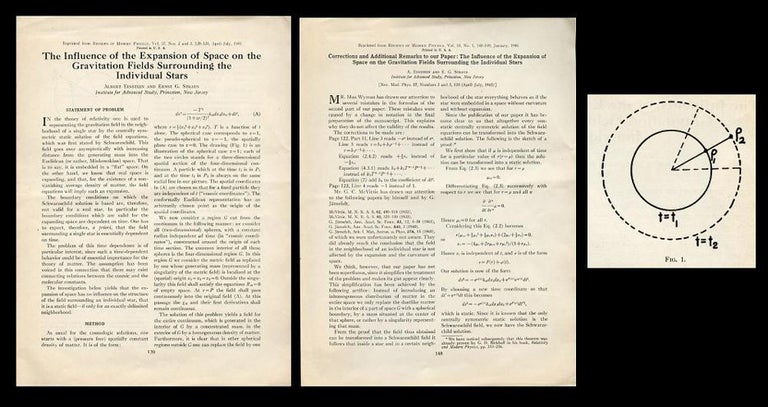The Influence of the Expansion of Space on the Gravitation Fields Surrounding the Individual Stars. WITH: Corrections and Additional Remarks to Our Paper
FIRST EDITION OFFPRINT OF EINSTEIN & STRAUS'S INTRODUCTION OF THE SWISS CHEESE MODEL OF THE UNIVERSE.
In 1931, Einstein published a paper with de Sitter "in which he favored, among the non static solutions for the universe, the simplest expanding model with vanishing pressure, zero cosmological constant, and Euclidean spatial sections; this model implies a singular origin of the universe (i. e., the universe has existed for a finite time). Einstein was never quite comfortable with such an idea of origin, nor indeed with singularities, which he thought to be generally incompatible with the concept of field" (Herherington, Encyclopedia of Cosmology, 195).
In early 1945, Einstein returned to his cosmological questions as he sought to try to understand whether the expansion of the universe caused the solar system to expand as well - or more specifically, the influence of the expansion of space on the gravitational field in the neighborhood of a star. Working with Ernest Straus at the Institute for Advanced Study at Princeton, the two began studying the effect of inhomogeneities in an expanding model. "By the spring of 1945, Einstein and Straus had found a new type of possible universe using Einstein's equations. It described a universe which looked largely like one of the simple expanding universes of Friedmann and Lemaître containing material (like galaxies) which exerted no pressure. But it has spherical regions removed from it, like bubbles in a Swiss cheese. Each empty hole then had a mass placed at its centre. The mass was equal in magnitude to what had been excavated to create the hole. This was a step towards a more realistic universe in which the matter was not smoothly spread with the same density everywhere but gathered up into lumps, like galaxies, which were spread about in empty space. (Barrow, The Book of Universes, 106-107). Einstein and Straus's work proved, among other things, that a unique solution of the problem of determining the field in the neighborhood of a star existed. Weil 216.
Note: Included is both the offprint of the initial paper as well as the offprint of the subsequently published corrections and additional discussion of the initial paper.
Offprints from: Reviews of Modern Physics, 17 & 18, 1945, pp. 120-124, pp. 148-149. Lancaster: American Physical Society, 1945. Quarto, original wrappers. Near-fine copies.
Check Availability:
P: 212.326.8907
E: michael@manhattanrarebooks.com

